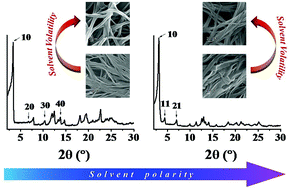Self-assembled nanostructures of amphiphilic zinc(ii) salophen complexes: role of the solvent on their structure and morphology†
Abstract
This contribution explores the effect of several solvent properties, such as volatility, polarity, and Lewis basicity on the formation of molecular self-assembled nanostructures in the solid state, obtained either by casting of related solutions or by complete solvent evaporation, using seven solvents representative of common classes of coordinating organic solvents, of an amphiphilic ZnII Schiff-base complex. In all cases, the existence of well-defined X-ray diffraction patterns, for both the cast and powder samples, indicates a strong tendency towards the molecular self-assembly of such complexes. While nanostructures formed in acetone, THF, pyridine, and DMF have a lamellar organization, those formed in ACN, ethanol, and DMSO exhibit a 2D columnar square structure. Field emission scanning electron microscopy analysis indicates that nanostructures formed in volatile acetone, THF, ACN, and ethanol solvents show a fibrous morphology, while those formed in less volatile pyridine, DMF, and DMSO have a ribbon appearance. Overall, the results indicate that while the formation of such nanostructures is independent of the Lewis basicity of the solvent, the solvent polarity affects their structure – more polar solvents favour higher symmetry structures – and the solvent volatility influences their morphology and ordering in the cast films – lower volatility of the solvent parallels the formation of much more ordered structures. Therefore, the appropriate choice of solvent allows control of the structure, morphology, and ordering of these molecular assemblies.


 Please wait while we load your content...
Please wait while we load your content...